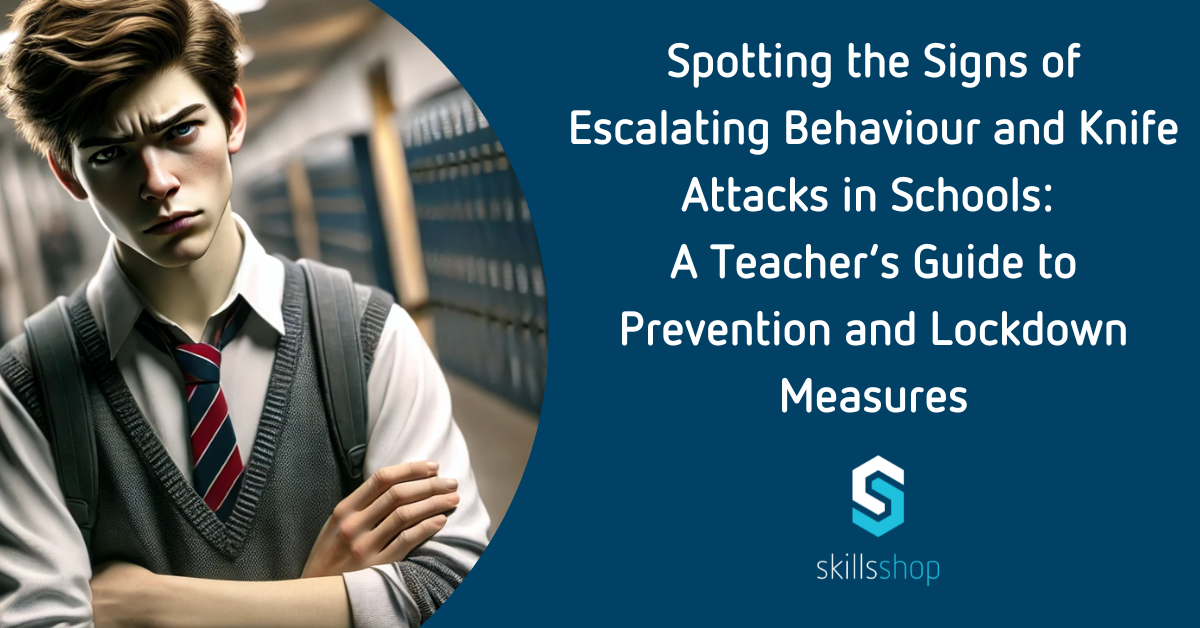As educators, we play a crucial role in ensuring the safety and well-being of our students. Behavioural escalation, particularly when moving from verbal abuse to physical aggression, is a serious concern. In some cases, this escalation can even lead to students carrying weapons, including knives, putting both themselves and others at risk. Recognising the early warning signs and understanding the Assault Cycle can help teachers intervene effectively, de-escalate situations, and protect their school community.
Understanding the Assault Cycle
]The Assault Cycle is a model that helps identify the stages of escalating behaviour leading to aggression. By recognizing these stages early, teachers can take action to prevent incidents before they become dangerous.
1️⃣ Trigger Phase
Something upsets the student, such as a conflict with peers, an argument at home, or even frustration over schoolwork. Teachers may notice restlessness, muttering, or withdrawal.
2️⃣ Escalation Phase
The student begins showing more obvious signs of distress. This may include raised voices, verbal threats, clenched fists, pacing, or an increase in argumentative behaviour.
3️⃣ Crisis Phase
This is the peak of aggression, where the student may lash out physically, throw objects, or engage in direct violent actions. If a student is carrying a knife, this is the stage where it is most likely to be used.
4️⃣ Recovery Phase
The student begins to calm down, though they may still be highly sensitive to external stimuli. They might withdraw, show signs of remorse, or appear exhausted.
5️⃣ Post-Crisis Depression Phase
Following an aggressive outburst, the student often experiences guilt, shame, or emotional exhaustion. This can be a critical time for teachers to offer support and reflection.
Warning Signs of Behaviour Escalation
Teachers should be on high alert for key warning signs, particularly when a student may be carrying a weapon:
- Increased secrecy and reluctance to remove bags or coats indoors
- Regular involvement in fights or intimidation of peers
- Displaying a heightened sense of paranoia or needing to “watch their back”
- Associating with known violent individuals or gangs
- Dropping veiled or direct threats about violence or carrying a knife
- Changes in behaviour, such as sudden aggression or detachment
- Unexplained injuries or damage to personal belongings
If you suspect a student may be carrying a knife or is at risk of violent escalation, follow your school’s safeguarding procedures immediately. It is always better to report concerns early than to wait for a crisis.
De-escalation Strategies for Teachers
When dealing with a student who is escalating towards aggression, consider the following approaches:
- Stay Calm: Use a calm and steady tone of voice to avoid fueling their anger.
- Give Space: Avoid cornering or crowding them, as this can increase their sense of threat.
- Listen Actively: Acknowledge their emotions without necessarily agreeing with their actions.
- Use Non-Threatening Body Language: Keep an open posture, avoid sudden movements, and maintain appropriate eye contact.
- Offer an Exit Strategy: Provide them with a way to de-escalate without losing face, such as stepping outside for a break.
- Seek Support: Never handle a violent situation alone—call for assistance from senior staff or security if necessary.
Implementing an Effective Lockdown Procedure
Should the unthinkable happen and a student brings a weapon onto the premises, a well-rehearsed lockdown procedure can help protect staff and students.
- Alert Staff and Authorities Immediately: Use a pre-established code word or alert system to notify all staff discreetly. Call the police at the earliest opportunity.
- Lockdown Classrooms and Secure Entry Points: Teachers should lock doors, close blinds, and keep students away from windows and doors.
- Stay Silent and Calm: Avoid making noise, and instruct students to remain silent and out of sight.
- Communicate Only When Safe: Follow school protocols for communicating with authorities. Avoid using mobile phones unless necessary to prevent causing panic.
- Do Not Engage with the Aggressor: Staff should never attempt to physically disarm a student. Wait for law enforcement to handle the situation.
- Post-Lockdown Support: Following the incident, offer trauma-informed support for students and staff. Consider counselling services and debriefing sessions.
Final Thoughts
By understanding the Assault Cycle, recognising early warning signs, and preparing for worst-case scenarios, teachers can play a pivotal role in preventing violence in schools. Being proactive, fostering strong relationships with students, and ensuring clear safety protocols are in place can make all the difference in keeping schools safe. Let’s work together to create an environment where every student feels supported, and every teacher feels equipped to handle challenging situations.
For further training on de-escalation techniques and safeguarding strategies, consider attending a Positive Behavioural Support (PBS) course tailored for educators.

